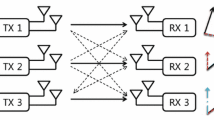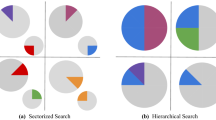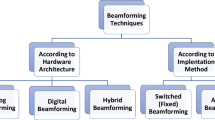Abstract
Hybrid (analog-digital) beamforming has received tremendous attention for realizing multiuser multiple-input-multiple-output systems at millimeter wave frequencies. However, almost all of the hybrid beamforming literature characterizes the spectral and energy efficiency performance for randomly located user terminals. In stark contrast, this article evaluates and compares the multiuser downlink ergodic sum spectral efficiency (ESSE) using different combinations of analog and digital beamforming techniques when users are closely-spaced. For any given combination of hybrid beamforming, we derive an analytical expression characterizing the loss of per-user ergodic spectral efficiency relative to fully digital beamforming. To get the negligible ESSE loss for both hybrid and fully digital beamforming, we quantify the angle-of-departure separation across multiple users, it is the term associated to the channel correlation induced by the user positions. We show the generality of the derived expression by testing it across a wide range of system dimensions, number of radio-frequency (RF) chains, and signal-to-noise ratios. Our results demonstrate that an extra RF chain may be sufficient to compensate most of the loss in ESSE due to closely-spaced terminals.





Similar content being viewed by others
Notes
We do not consider the elevation characteristics of the channel. In a typical small-cell deployments, UEs are much more likely to be clustered or lying in random positions across the azimuth plane rather than in elevation. This has been observed in real deployments reported in [3].
References
Rusek, F., et al. (2012). Scaling up MIMO: Opportunities and challenges with very large arrays. IEEE Signal Processing Magazine, 30, 40–60.
Roh, W., et al. (2014). Millimeter-wave beamforming as an enabling technology for 5G cellular communications: Theoretical feasibility and prototype results. IEEE Communications Magazine, 52, 106–113.
Shafi, M., et al. (2017). 5G: A tutorial overview of standards, trials, challenges, deployment, and practice. IEEE Journal on Selected Areas in Communications, 35, 1201–21.
Swindlehurst, A. L., et al. (2014). Millimeter-wave massive MIMO: The next wireless revolution? IEEE Communications Magazine, 52, 56–62.
Sadhu, B., et al. (2017). A 28-GHz 32-element TRX phased-array IC with concurrent dual-polarized operation and orthogonal phase and gain control for 5G communications. IEEE Journal of Solid-State Circuits, 52, 3373–91.
Björnson, E., et al. (2019). Massive MIMO in sub-6 GHz and mmWave: Physical, practical, and use-case differences. IEEE Wireless Communications, 26, 100–108.
Tataria, H., et al. (2018). Uplink interference analysis with RF switching for lens-based millimeter-wave systems. In IEEE International Conference on Communications (ICC) (pp. 1–7).
Zhang, X., Molisch, A. F., & Kung, S. Y. (2005). Variable-phase-shift-based RF-baseband codesign for MIMO antenna selection. IEEE Transactions on Signal Processing, 53, 4091–103.
El Ayach, O., Rajagopal, S., Abu-Surra, S., Pi, Z., & Heath, R. W. (2014). Spatially sparse precoding in millimeter wave MIMO systems. IEEE Transactions on Wireless Communications, 13, 1499–513.
Sohrabi, F., & Yu, W. (2016). Hybrid digital and analog beamforming design for large-scale antenna arrays. IEEE Journal of Selected Topics in Signal Processing, 10, 501–13.
Liang, L., Xu, W., & Dong, X. (2014). Low-complexity hybrid precoding in massive multiuser MIMO systems. IEEE Wireless Communications Letters, 3, 653–6.
Li, Z., Han, S., & Molisch, A. F. (2017). Optimizing channel-statistics-based analog beamforming for millimeter-wave multi-user massive MIMO downlink. IEEE Transactions on Wireless Communications, 16, 4288–303.
Castellanos, M. R., et al. (2018). Channel-reconstruction-based hybrid precoding for millimeter-wave multiuser MIMO systems. IEEE Journal of Selected Topics in Signal Processing, 12, 383–398.
Perera, S. M., et al. (2018). Wideband \( N \)-beam arrays using low-complexity algorithms and mixed-signal integrated circuits. IEEE Journal of Selected Topics in Signal Processing, 12, 368–82.
Sun, S., Rappaport, T. S., Shafi, M., & Tataria, H. (2018). Analytical framework of hybrid beamforming in multi-cell millimeter-wave systems. IEEE Transactions on Wireless Communications, 17, 7528–43.
Raghavan, V., Partyka, A., Akhoondzadeh-Asl, L., Tassoudji, M. A., Koymen, O. H., & Sanelli, J. (2017). Millimeter wave channel measurements and implications for PHY layer design. IEEE Transactions on Antennas and Propagation, 65, 6521–33.
Cheng, M., et al. (2018). Coverage analysis for millimeter wave cellular networks with imperfect beam alignment. IEEE Transactions on Vehicular Technology, 67, 8302–8314.
Yu, X., et al. (2017). Coverage analysis for millimeter wave networks: The impact of directional antenna arrays. IEEE Journal on Selected Areas in Communications, 35, 1498–1512.
Babich, F., & Comisso, M. (2016). Including the angular domain in the analysis of finite multi-packet peer-to-peer networks with uniformly distributed sources. IEEE Transactions on Communications, 64, 2494–2510.
Sadek, M., Tarighat, A., & Sayed, A. H. (2007). A leakage-based precoding scheme for downlink multi-user MIMO channels. IEEE Transactions on Wireless Communications, 6, 1711–21.
Xu, G., et al. (2017). Full dimension MIMO (FD-MIMO): Demonstrating commercial feasibility. IEEE Journal on Selected Areas in Communications, 35, 1876–86.
Tataria, H. (2017). Analysis of multiuser cellular systems over heterogeneous channels. Ph.D. Thesis, Victoria University of Wellington
Acknowledgements
This work has been supported by an IRSIP fellowship from the Higher Education Commission (HEC), Pakistan. We thank Dr. H. Tataria (HT Consulting, New Zealand) and Prof. M. Shafi (Spark, New Zealand) for valuable guidance and insights gained from discussions throughout the course of this work. In particular, we thank Dr. H. Tataria for providing mathematical derivations in Sect. 4.
Author information
Authors and Affiliations
Corresponding author
Additional information
Publisher's Note
Springer Nature remains neutral with regard to jurisdictional claims in published maps and institutional affiliations.
Appendices
Appendix 1: Derivation of SE bound for hybrid beamforming
Note that expectation in (13) is over the small-scale fading in the propagation channel coefficients. Since \(\textbf{H}_{\text {eq}}\textbf{H}_{\text {eq}}^H\) is a positive definite Hermitian matrix, by virtue of eigenvalue decomposition, we can express \(\textbf{H}_{\text {eq}}\textbf{H}_{\text {eq}}^H=\textbf{U}\varvec{\Sigma }\textbf{U}^H,\) where \(\varvec{\Sigma }\in \mathcal {C}^{K\times {}K}\) is the eigenvalue matrix and \(\textbf{U} \in \mathcal {C}^{K \times K}\) is a unitary matrix. Noting that the sum of the eigenvalues in \(\varvec{\Sigma }=\text {tr}(\varvec{\Sigma })\), we can rewrite \(\tilde{\beta }\) with
Now, our function of interest is in the form \(f(x)=x^{-1}\) and \(x>0\), which is a strictly decreasing convex function. Exploiting this, we can bound the eigenvalues in \(\varvec{\Sigma }\) such that
Based on these manipulations, we have
Using (19), the expression in (13) can be written as
Using Jensen’s inequality for strictly convex functions, the expectation is brought inside the logarithmic term, giving the result in Proposition 1
The expectation is taken over the raw channel entries in \(\textbf{H}\), giving rise to the result above.
Appendix 2: Derivation of SE bound for fully digital beamforming
For the fully digital case, when there is no RF precoding, \(\textbf{H}_{\text {eq}}=\textbf{H}\). Based on this, \(\textbf{F}_{\text {BB}}^{\text {eq}}= ~ \textbf{H}^H(\textbf{H}\textbf{H}^H)^{-1}\) is the fully digital precoding matrix, resulting in the per-user ergodic SE of
Rights and permissions
Springer Nature or its licensor (e.g. a society or other partner) holds exclusive rights to this article under a publishing agreement with the author(s) or other rightsholder(s); author self-archiving of the accepted manuscript version of this article is solely governed by the terms of such publishing agreement and applicable law.
About this article
Cite this article
Kayani, A., Woodward, G.K., Khalid, Z. et al. On the performance of hybrid beamforming for closely-spaced and randomly located users. Wireless Netw 29, 2609–2617 (2023). https://doi.org/10.1007/s11276-023-03335-3
Accepted:
Published:
Issue Date:
DOI: https://doi.org/10.1007/s11276-023-03335-3




